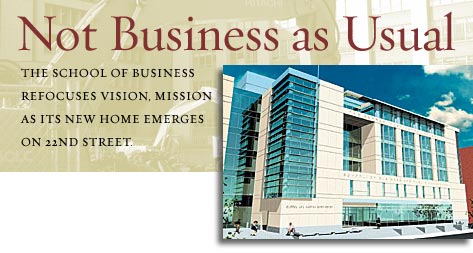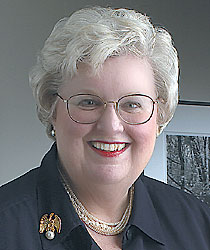
Architect’s rendering of Duquès Hall, the new home for the business school, scheduled to open next year.

By Heather 0. Milke
It’s Dean Susan Phillips’ sixth year at the GW School of Business. When she became dean in July 1998, the former governor of the U.S. Federal Reserve System took on several challenges, including reaccredidation and aging facilities.
In 1999, the school was reaccredited and its accountancy programs, having undergone an additional intense review, received initial accreditation. Next, in 2003, the school completed the first phase of its building campaign ahead of schedule. The new building—to be named Duquès Hall, thanks to a naming gift from Ric Duquès, BBA ’65, MBA ’69, and Dawn Duquès, BA ’68—will connect to a renovated Funger Hall and should open in 2005.

GW School of Business Dean Susan Phillips
|
As the new building rises on 22nd Street, Phillips’ other initiatives are beginning to take shape. During the school’s 75th anniversary two years ago, she co-chaired a team that led the school through a process to revamp its vision and mission and develop a strategic plan to guide the school for the next five to 10 years. The result of this intense process— which involved faculty and staff members, alumni, the school’s board of advisers, and the business community—is a new focus that will take the school forward as it moves into its $50 million state-of-the-art home. Phillips and her colleagues are now conducting curriculum reviews of each degree program with respect to the school’s new direction, the planned move into Duquès Hall, and changes in the business environment.
In recent years, GW has become increasingly attractive to prospective undergraduate students, and as a result the business school has grown in size and selectivity. “We’ve more than doubled the size of the entering undergraduate classes in the last 10 years,” Phillips says, adding that this year the business school’s total undergraduate enrollment will probably be in the neighborhood of 1,600 students. Meanwhile, the average SAT score for a freshman entering the business school has climbed nearly 100 points over the same period. GW’s undergraduate business program is now ranked in the top 50 in the U.S. News & World Report rankings and has been for the past five years. And a recent Wall Street Journal report ranked the MBA program 37th in the regional category of its annual “WSJ Guide to Business Schools: Recruiters’ Top Picks.”
The school has always been strong in graduate enrollment, due in part to its menu of several specialized masters programs that complement its MBA programs. While graduate enrollment numbers have remained fairly constant, “We’ve been ratcheting up the quality on the graduate side,” Phillips notes, pointing to a reduction in the size of the full-time MBA program, which is becoming more selective. GW launched its MBA program in 1952, and introduced a full-time cohort program in 1995. Since then, GW’s full-time MBA program has attracted candidates with more work experience and higher test scores and undergraduate grade point averages.
With the new vision set forth for the school, Phillips has her eye out for the school’s programs to make their marks. “Our MBA program tends to rank in the 60 to 70 range, but we’d like to get into the top 50,” she says. “How are we going to do that? We’ve got to emphasize quality scholarly research and teaching excellence.”
Rankings attract attention, but clearly fostering excellence is not just about the numbers. The school also is emphasizing improvement measures within each of its academic departments. One initiative among all departments is the school’s emphasis on global studies.
Leading that effort is easier, thanks to the business school’s international roots and its well-regarded international business department, which not all schools have. “We have a strong international faculty, international students, and a number of international programs. We’re looking at the global environment—the management of organizations in the global environment,” Phillips says.
Allowing students to have the opportunity for hands-on learning is another key element of the school’s plan, Phillips notes. “We want to continue to leverage our location in Washington. One of the things I hear from parents is that the vast internship opportunities that GW offers are just incredible. We also get adjunct faculty with great credentials—folks from the Securities and Exchange Commission or the World Bank Group—and speakers who are based in Washington or fly in for business.”
Additionally, counteracting some of the bad press the business world has experienced in recent years, the school is concentrating on better integrating ethics into its curricula and other programs. The school is searching for a professor to fill the new Lindner-Gambal Professorship in Business Ethics, which A. James Clark, chairman of Clark Enterprises, endowed last spring in honor of business colleagues and GW alumni Thaddeus A. Lindner, BA ’51, and Sergius Gambal, BA ’52. The school eventually also might launch a research center focused on business and ethics, which will give students another perspective on their studies. “We want our graduates to be productive and principled members of society,” Phillips says.
Other areas of strength for the school include finance and accounting, information systems, and GW’s unique program in tourism/hospitality management—a big industry for Washington, as well as an emphasis on strategic management and public policy.
GW’s business school is one of the top six schools in the world for research and teaching about environmentally and socially sustainable management, Phillips says. “With this award, which we have received for several years now, we are in very good company, with public universities, the University of North Carolina and University of Michigan, and private universities Stanford and Yale.”
Eleven new full-time members joined the school this fall. Securing these professors was no small feat, given the shortage of business faculty that creates a competitive market situation. “There’s a real bidding war for the best and the brightest,” Phillips notes. Among the additions are Richard K. Green, the new Oliver T. Carr Jr. Chair of Real Estate Finance, as well as professors in accounting, international business, management science, strategic management and public policy, and tourism studies.
When the business school relocates to its new six-story building, it will finally be able house its seven academic departments and many other programs and units under one roof. Currently, the school occupies eight different locations on campus, which hinders cross-departmental communication and multidisciplinary collaboration.
Further, students will enjoy high-tech classrooms with built-in audiovisual technology in each room. Students also will be able to use team rooms and break out rooms for the group work involved with a GW business education. “Students will no longer have to sit in on the floor in the hallway to do team projects,” Phillips says. These features are long due for the school, which has waited its turn at GW for a new building. Indeed, in 1938 the school, then known as the School of Government, became the first GW school to be housed in its own building—the Hall of Government, where it has remained for the past 66 years.
Technology in the building will include the ability to use wireless laptops to access the Internet. There also will be computer labs as well as a capital markets room, where students can access real-time quotes and use proprietary software for financial modeling, trading, and portfolio management.
A large auditorium on the first floor will enable the school to host guest speakers and other major events in its own building rather than across campus. The school’s F. David Fowler Graduate Career Center and other student service providers also will be located in the new building.
Outside the building other hallmark programs will continue while newer ones are just getting started and being explored. Distance education as well as customized MBA programs for corporate partners like SAIC and the Mandarin Oriental Hotel Group will continue. And this year, the school is planning to add a winter break study-abroad program in India to its line-up of programs in Europe and South America.
Moving forward, the school also is placing a greater emphasis on faculty and student research. The school aims to provide more research support for faculty, and last year it launched the Research Experience for Undergraduates. The program encourages faculty to engage full-time undergraduate students in their research projects in substantive ways and is designed to sow the seeds of research in the minds of undergraduate students. The next phase of the school’s building campaign, Building Human Capital, will raise resources for areas such as scholarships, professorships, and research, areas that the school’s stakeholders identified as important during the school’s strategic analysis.
It’s all a matter of setting goals and moving forward with the times, says Phillips, who is well known for her forecasting abilities as a former Fed governor. Just as the school’s long-range plans are reviewed, a process that Phillips has led in recent years, “It’s a continuous changing process,” she says. “Business changes, the issues change, and so we have to keep up the curriculum but also find new ways to deliver it.”
Back to top | Fall 2004 Table of Contents
|